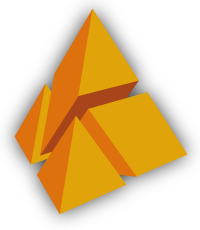

|
Polymake Template Library (PTL)
4.2
|
PTL is based on STL and makes exhaustive use of the three main concepts of the latter: containers, iterators, and functors. There is a subtle difference, however, in the implementation of algorithms: in STL, they are designed to work with iterators, while in PTL the most of them accept containers as arguments. PTL containers are more than pure data structures, they bear some additional semantics, in that they belong to one of the generic families. See http://www.cplusplus.com/reference/stl/ for a description of STL's container concept.
Besides real containers, which own their data as prescribed by the standard, PTL makes heavy use of Container Manipulations. The latter implement though the standard container interface, but do not possess any data at all; instead, they refer to other container objects supplying the data items. There are three kinds of pseudo-containers in PTL: alias_sec alias, masquerade_sec masquerade, and lazycontainers".
Many operators defined for PTL container classes, such as vector and matrix arithmetic, set-theoretical operations, etc., don't perform the computations immediately, but rather create a temporary object which "remembers" the operands and the operation and evaluates it later, on demand. This is a well-known technique called lazy evaluation, sometimes also referred to as expression templates. It helps to spare unnecessary computations and copying of objects.
The lazy objects fit well in the container concept of PTL, as they always belong to the same generic family and implement the same container interface as the result of the real operation would do.
The vector class family implement vectors in the usual algebraic notion. It contains three persistent vector types with different data storage organization. These implementations result in performance differences for various functions on vectors.
ElementType(), which is 0 for most numerical types) are not stored, but implicitly encoded by the gaps in the key set. It is based on an AVL tree.The matrix class family implement matrices in the usual algebraic notion. It contains three persistent matrix types with different data storage organization.
ElementType(), which is 0 for most numerical types) are not stored, but implicitly encoded by the gaps in the key set. Each row and column is organized as an AVL::tree.std::list. Can be parameterized with any persistent vector type".These are borrowed from GMP and wrapped.
 1.8.17
1.8.17